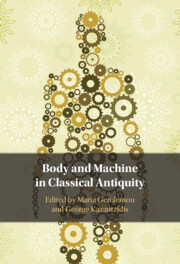Book contents
- Body and Machine in Classical Antiquity
- Body and Machine in Classical Antiquity
- Copyright page
- Contents
- Figures
- Contributors
- An Introduction to Body–Machine Intersections
- Part I Blended Bodies
- Part II The Technological Body
- Part III Towards the Mechanization of the Human Body
- Index of Passages
- General Index
- References
An Introduction to Body–Machine Intersections
Published online by Cambridge University Press: 13 July 2023
- Body and Machine in Classical Antiquity
- Body and Machine in Classical Antiquity
- Copyright page
- Contents
- Figures
- Contributors
- An Introduction to Body–Machine Intersections
- Part I Blended Bodies
- Part II The Technological Body
- Part III Towards the Mechanization of the Human Body
- Index of Passages
- General Index
- References
Summary
*In December 2018, a group of archaeologists, philosophers, historians and classicists came together at the University of Cyprus to discuss body–machine interactions in Greek and Roman antiquity. The idea for this volume has grown from that conversation. We would like to thank the University of Cyprus and the Department of Classics there for their support.
- Type
- Chapter
- Information
- Body and Machine in Classical Antiquity , pp. 1 - 16Publisher: Cambridge University PressPrint publication year: 2023



